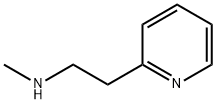
Бетагистин
- английское имяBetahistine
- CAS №5638-76-6
- CBNumberCB4489793
- ФормулаC8H12N2
- мольный вес136.19
- EINECS227-086-4
- номер MDLMFCD00006362
- файл Mol5638-76-6.mol
| Температура кипения | 113-114 °C30 mm Hg(lit.) |
| плотность | 0.984 g/mL at 25 °C(lit.) |
| давление пара | 17.7Pa at 25℃ |
| показатель преломления | n |
| Fp | 206 °F |
| температура хранения | Keep in dark place,Inert atmosphere,Room temperature |
| растворимость | Chloroform (Slightly), DMSO (Sparingly), Ethyl Acetate (Slightly), Methanol (Slightly) |
| пка | pKa 3.46 (Uncertain) |
| форма | Oil |
| цвет | Light Yellow to Yellow |
| Растворимость в воде | 1000g/L at 25℃ |
| Мерк | 13,1181 |
| LogP | 0.68 |
| Справочник по базе данных CAS | 5638-76-6(CAS DataBase Reference) |
| FDA UNII | X32KK4201D |
| Код УВД | N07CA01 |
| Система регистрации веществ EPA | 2-Pyridineethanamine, N-methyl- (5638-76-6) |
| UNSPSC Code | 12352100 |
| NACRES | NA.22 |
| Коды опасности | Xi,C | |||||||||
| Заявления о рисках | 36/37/38 | |||||||||
| Заявления о безопасности | 26-37/39 | |||||||||
| WGK Германия | 2 | |||||||||
| RTECS | UT5552000 | |||||||||
| Примечание об опасности | Corrosive | |||||||||
| кода HS | 2933399990 | |||||||||
| NFPA 704: |
|
рисовальное письмо(GHS)
-
рисовальное письмо(GHS)

-
сигнальный язык
предупреждение
-
вредная бумага
H315:При попадании на кожу вызывает раздражение.
H319:При попадании в глаза вызывает выраженное раздражение.
H335:Может вызывать раздражение верхних дыхательных путей.
-
оператор предупредительных мер
P261:Избегать вдыхания пыли/ дыма/ газа/ тумана/ паров/ аэрозолей.
P264:После работы тщательно вымыть кожу.
P271:Использовать только на открытом воздухе или в хорошо вентилируемом помещении.
P280:Использовать перчатки/ средства защиты глаз/ лица.
P302+P352:ПРИ ПОПАДАНИИ НА КОЖУ: Промыть большим количеством воды.
P305+P351+P338:ПРИ ПОПАДАНИИ В ГЛАЗА: Осторожно промыть глаза водой в течение нескольких минут. Снять контактные линзы, если Вы ими пользуетесь и если это легко сделать. Продолжить промывание глаз.
Бетагистин химические свойства, назначение, производство
Описание
Betahistine is an analogue of histamine with weak agonist properties at histamine H1 receptors and more potent antagonistic effects at histamine H3 receptors.This drug is broadly used worldwide, except for the USA, since it has not been approved by the US Food and Drug Administration. Betahistine is a structural analog of histamine that acts as a weak partial postsynaptic histamine H1 receptor agonist and presynaptic H3 receptor antagonist, with no effect on postsynaptic H2 receptors (Gbahou et al, 2010). The mechanism of action of the drug appears to depend mainly on its action on H3 receptors mediated by two metabolites, aminoethylpyridine and hydroxyethylpyridine (Bertich et al, 2014).
Использование
Betahistine is a vasodilator, a mild H1 histamine agonist, and a potent H3 histamine antagonist. The mechanism of action in Meniere's disease is unknown, but theories include reducing the endolymphatic pressure through improved circulation in the stria vascularis or inhibiting activity in the vestibular nuclei. It has been found to be a safe drug with a very low side effect profile. Betahistine was FDA approved for Meniere's disease in the US market for a short period of time in the 1970s, but approval was then rescinded due to lack of evidence supporting its efficacy. However, based on clinical experience and several observational studies, it is still widely used elsewhere in the world.Показания
Betahistine is indicated in treatment of Meniere's disease (vertigo, hearing loss and tinnitus); it is not effective in preventing vertigo attacks.Механизм действия
The precise mechanism of betahistine's actions is unclear; it has antagonistic actions on histamine H3 receptors, and is a weak agonist at H receptors. In animal studies, it inhibits generation of spikes in vestibular nuclei. Its vasodilator activity (similar to histamine's) presumably improves blood flow in the inner ear and brainstem.Фармакокине?тика
After oral administration, betahistine is rapidly and completely absorbed, rapidly metabolised (to one major metabolite, 2-pyridylacetic acid) and 90% excreted within 24 hours. Plasma and urinary half-lives are about 3.5 hours.Побочные эффекты
Common adverse reactions include headache, nausea and dyspepsia. More rarely, hypersensitivity reactions (rash, pruritis, bronchospasm) and hypotension may occur.взаимодействия лекарств
Co-administration of betahistine and monoamine oxidase inhibitors type B reduces metabolism of betahistine. Theoretically, interactions might occur with concurrent antihistamines; however, no significant problems have been reported.Меры предосторожности
Betahistine should be used with caution in individuals with asthma, urticaria, phaeochromocytoma or hypersensitivity to any components of tablets. Betahistine is contraindicated in people with active or history of peptic ulcer. Betahistine is classified in Pregnancy Safety Category B2: insufficient data available; it is contraindicated in pregnancy and lactation, and in children under 18.Бетагистин запасные части и сырье
Бетагистин поставщик
| поставщик | телефон | страна | номенклатура продукции | благоприятные условия | |
|---|---|---|---|---|---|
| +8617342059697 | China | 315 | 58 | ||
| +86-0371-55170693 +86-19937530512 |
China | 21630 | 55 | ||
| +undefined-21-51877795 | China | 33024 | 60 | ||
| 18871490254 | CHINA | 28172 | 58 | ||
| +1-631-485-4226 | United States | 19552 | 58 | ||
| 8485655694 | United States | 63687 | 58 | ||
| +8618523575427 | China | 49732 | 58 | ||
| +86-0371-86658258 +8613203830695 |
China | 29808 | 58 | ||
| +8613385739570 | China | 226 | 58 | ||
| +8618530059196 | China | 12114 | 58 |